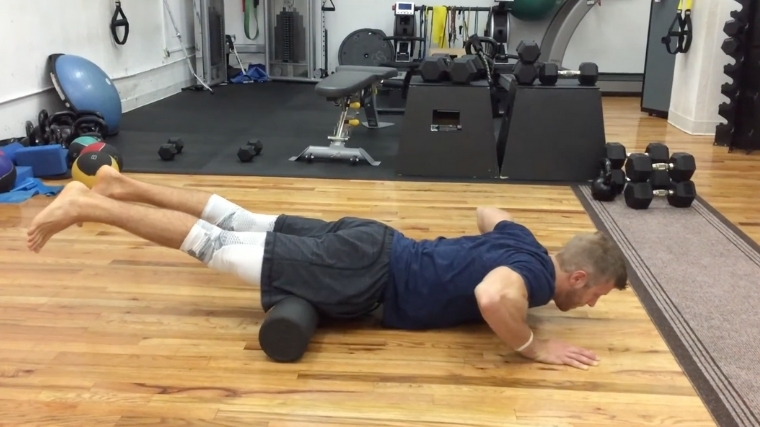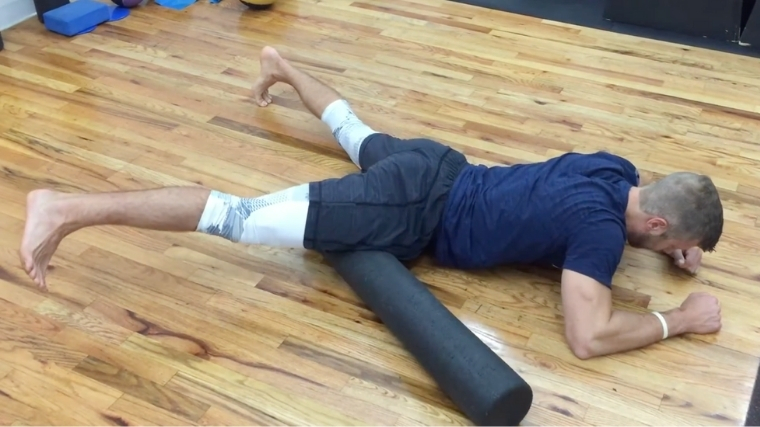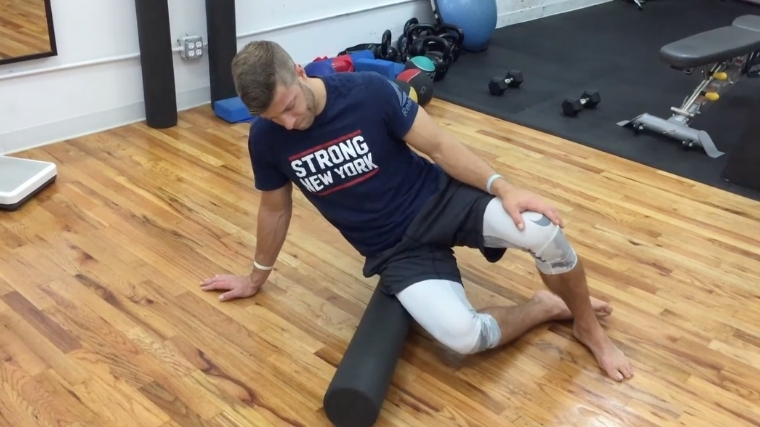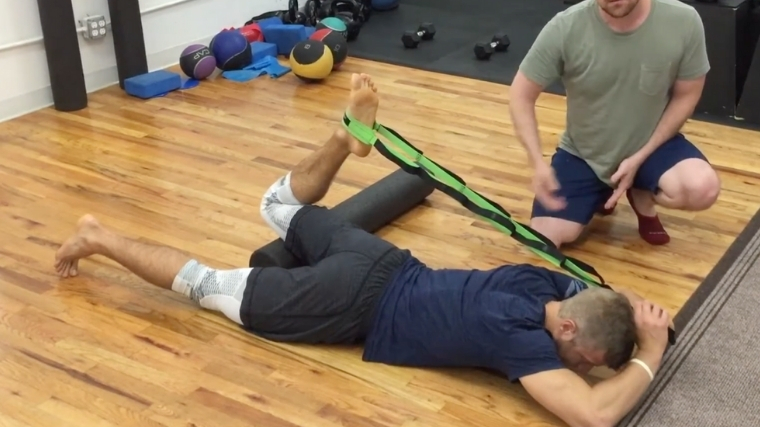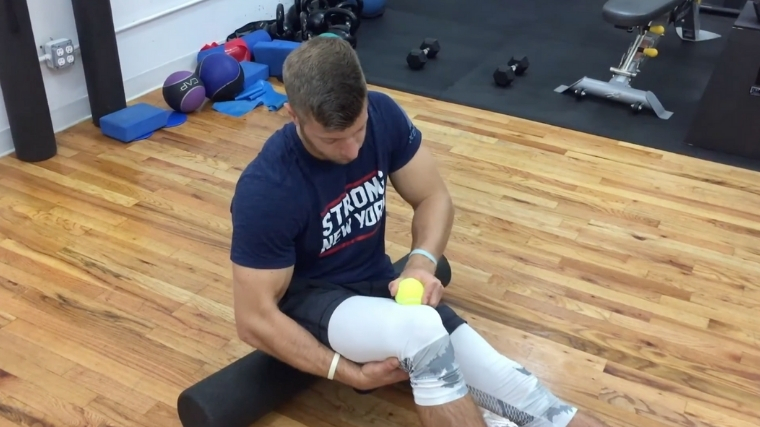Foam rolling is a great tool for warming up, cooling down, and improving your mobility. One of the areas on the body that gets excessively tight and painful is the quads. The reason for tight quads is usually excessive workload, too much sitting, or lack of stretching after training.
We wanted a sequence that hit the quads evenly and focused on all the trouble spots. To help you effectively roll out the quads, we consulted Matt Moskowitz, Head of Training at Hell’s Kitchen Wellness, to learn how he approaches foam rolling the quads. Check out the video below, along with more detailed movement descriptions in the article.
Best Foam Rolling Exercises For Quads
Editor’s note: The content on BarBend is meant to be informative in nature, but it shouldn’t take the place of advice and/or supervision from a medical professional. The opinions and articles on this site are not intended for use as diagnosis, prevention, and/or treatment of health problems. Speak with your physician if you have any concerns.
Best Foam Rolling Exercises for Quads Video
Check out our video guide, featuring former BarBend training editor Jake Boly, for more information on how to roll out your quads properly.
[Related: Everything You Need to Know to Build Your First Workout Program]
Understanding the Quad Rolling Sequence
This foam rolling sequence is focused on hitting multiple areas of the quad and anterior leg muscles. Rarely is one quad muscle tight, but it’s an accumulation of muscles and tendons that are tight. Below are a few areas of the quad and anterior leg this foam rolling sequence will cover.
- Rectus Femoris
- Vastus Lateralis
- Vastus Medialis
- Vastus Intermedius
- Sartorius
- Iliotibial Band
Some quad muscles may be tighter than others, so it’s important to keep note of excessively tender areas and ease into the various movements in this sequence to avoid pain. It’s better to ease into an exercise and not create more pain due to excessive pressure. To do the sequence, go through each movement once. Perform each exercise for 30 seconds on each side (if applicable) and then move on to the next one.
Femoris Roll
Although it’s called the femoris roll, this exercise hits all four quad muscles to some degree. The rectus femoris crosses two joints making it an important muscle for hip mobility and knee extension. And performing this roll before training will improve your mobility plus recovery of your quads and hip flexors after training.
[Related: What You Need to Know About How to Increase Strength]
The Benefits of the Femoris Roll
- Massages all four quad muscles.
- Improves hip mobility and knee extension.
How to Do the Femoris Roll
Kneel on the floor and place the foam roller right in front of both knees. From there, bring your body forward to the floor, and ensure their hips and body are grounded to prevent any form of back pain. Once the roller is under your quads and your body is on the floor, begin rolling forwards and backward to massage the femoris.
Small Medialis Roll
The vastus medialis plays an important role in locomotion (a fancy word for movement) and other basic athletic movements because it helps the kneecap track correctly. Plus, with the help of three other quad muscles, it’s a powerful knee extensor. Because of the vastus medialis proximity to the kneecap, It’s also an important knee stabilizer, a function that’s often neglected. And spending some time here may reduce knee pain.
[Related: Best Pre-Workout Supplements for Strength, Cardio, and More]
The Benefits of the Small Medialis Roll
- It helps to improve knee stabilization.
- May reduce knee pain.
How to Do the Small Medialis Roll
Place the roller slightly angled out from the knee as if it’s at two o’clock from the kneeling position. Slowly bring your body to the floor and place weight on the medial side of the quad, and then angle the hip down to put more weight on the medialis as you’re rolling back and forth.
Lateralis Roll
The vastus lateralis muscle is the largest and most powerful muscle of the four quad muscles. The strength and stability of this muscle help absorb the impact of daily activities such as running. Plus, it’s the main muscle that extends the knee when you’re squatting, and spending some quality time with this exercise may improve your squat performance.
[Related: The 8 Best Barbell Exercises for Mass, Strength, and Power]
The Benefits of the Lateralis Roll
- Reduces quad tightness to improve knee extension.
- Rolling it as part of your warmup will help improve your squat.
How to Do the Lateralis Roll
Position the roller parallel to the side of the leg from the kneeling position. Then bring your body weight over the roller, so the lateral side of the quad is in contact with the roller. Then push back on forth using your foot on the ground, rolling between the hip and knee.
Sartorius Stretch
The sartorius is a unique muscle as it functions as a hip and knee flexor. It also plays a small role in hip rotation. If this muscle is excessively tight, it may prevent you from going through your full range of motion on all your leg exercises. Although most quad stretches will hit this muscle, performing a prone stretch with a strap or towel really focuses on the sartorius.
[Related: Best Dumbbells for Durability, Adjustability, Premium Options, and More]
The Benefits of the Sartorius Stretch
- Improves hip mobility, knee extension, and hip rotation.
- Reduces tightness of your quads to improve performance in the gym and improve your recovery after leg day.
How to Do the Sartorius Stretch
Lie face down on the ground and place a foam roller under the quad about three to five inches above the knee. Then take a stretching strap, band, or towel and rope it around the ankle or foot and gently pull it towards the back of your head so the full length of the quad receives a stretch.
Tennis Ball Self Massage
Although the medialis roll massages the vastus medialis, using a tennis ball applied with the right amount of pressure will focus on the sore, tight, and tender spots missed by medialis roll. As you’re controlling your own intensity, be careful not to massage into excessive pain. When you find a sore spot, spend some quality time there to help reduce knee pain or improve recovery.
[Related: The Best Kettlebells for Beginners, CrossFit, and Cardio]
The Benefits of the Tennis Ball Self Massage
- You control the intensity by how hard or soft you press the ball into your thigh.
- Allows you to hone in on the sore spots missed by the Medialis roll.
How to Do the Tennis Ball Self Massage
Sit on a foam roller and bring one leg up to a 90-degree angle with your foot on the ground and your other leg straight. From here, grab under the quad and push the muscle up to provide a bigger surface area for the tennis ball. Taking the tennis ball in the other hand, press into the medialis, and perform a twisting motion like you’re removing a bottle cap.
Anatomy of the Quadriceps
The quadriceps are four muscles and combined. They’re the strongest muscles of the human body. These four muscles are on the anterior thigh and the sartorius muscle, and their actions are knee extension and hip flexion.
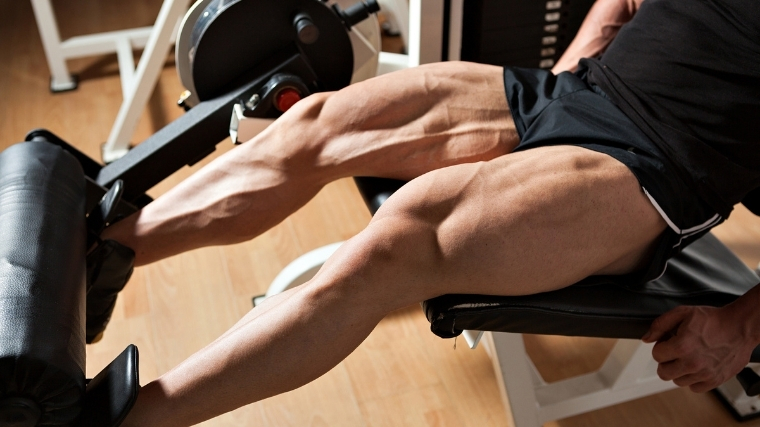
Rectus Femoris
This muscle lies underneath the three other quad muscles, and it crosses two joints, the hip and the knee. The rectus femoris originates on the anterior inferior iliac spine and attaches to the knee via the patella tendon. Its two main movements are knee extension and hip flexion.
Vastus Medialis
Often known as the “teardrop” muscle on the medial part of the knee, the vastus medialis originates from the intertrochanteric line, pectineal line of the femur (anterior femur near the pelvis), and attaches to the tibial tuberosity (below the kneecap) via the patellar tendon. This muscles only function is knee extension.
Vastus Lateralis
Vastus lateralis is the largest of all four quad muscles. This originates from the intertrochanteric line (near the hip joint), greater trochanter (bony attachment near the hip joint), and the gluteal tuberosity (lateral posterior surface of the femur). This muscle attaches to the tibial tuberosity via the patellar tendon. The sole function of the vastus lateralis is knee extension.
Vastus Intermedius
This muscle lies between the vastus lateralis and vastus medialis muscles, and it originates from the anterior surface of the femur, on the straight part of the bone. This attaches to the tibial tuberosity via the patellar tendon on the lateral part of the knee. Again, its only action is knee extension.
Sartorius
This is the longest muscle in the human body, and it’s a thin muscle that runs down the length over the other four quad muscles. It originates from the anterior superior iliac spine (above the hip joint) and attaches to the anteromedial surface of the tibia. The sartorius muscle acts on the hip and knee-joint but only weakly. Its hip actions are flexion and abduction, and it can flex the knee but only when the knee is already flexed.
The Benefits of Foam Rolling the Quads
Foam rolling the quads before training gets your legs ready for action and improves recovery after a tough leg workout. Here are a few other benefits of foam rolling the quads.
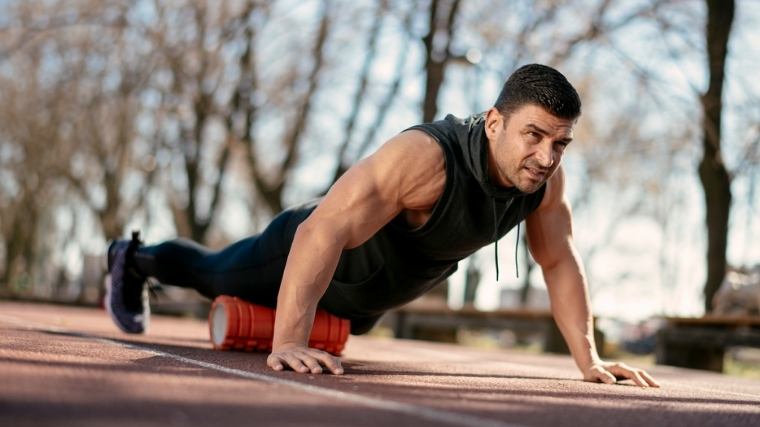
Reduced Quad Soreness
In a study published by the Journal of Athletic Training, men who foam rolled their legs after a workout reported decreased post-workout tenderness. They used a roller for 20 minutes after their workout and again 24 and 48 hours later. (1)
Improves Joint Range of Motion
When reducing muscle adhesions in the fascia, particularly the hip flexors. you’ll improve the muscles’ elasticity and help them return to their ideal length. This allows the hip joint to go through a greater range of motion to help promote better movement of the hip, leg, knee, and ankle.
Better Performance
Foam rolling the quads improves the mobility of your hips to help improve your range of motion with your squats and deadlifts, to help strengthen all parts of the movement.
More Foam Roller Training Tips
Now that you have a handle on the best foam rolling exercises for the quads, you can also check out these other helpful foam rolling articles for strength, power, and fitness athletes.
References
- Gregory E P Pearcey et al. Foam rolling for delayed-onset muscle soreness and recovery of dynamic performance measures. J Athl Train. 2015 Jan;50(1):5-13. doi: 10.4085/1062-6050-50.1.01. Epub 2014 Nov 21
Featured image: JustLife/Shutterstock
